India in Pictures – Goa, Mangalore, Cochin
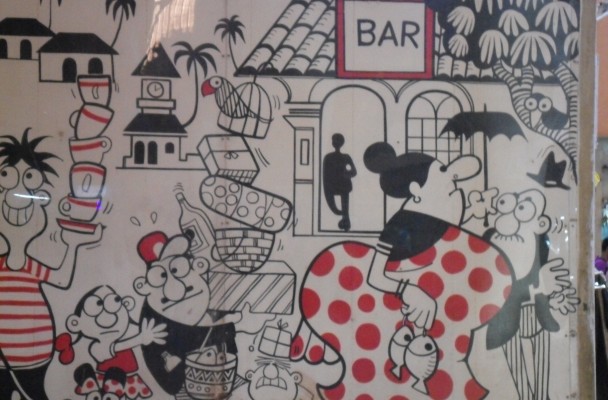
The drawings on the walls in the town market are an unexpected delight
Goa, located in West India in the region known as the Konkan, belonged to Portugal for 450 years until it was annxed by India in 1961, and is an
eclectic blend of Portuguese and Indian cultures and different religions found in western India. An estimated 66% of the population is Hindu, 27%Christian, and 7% Muslim; the remainder is made up of Sikhs, Buddhists, Jains and other religious communities. Panjim is the capital but Vasco da Gama is the largest city. The official language is Konkani but English is widely known and use. Portuguese is spoken by only the elderly Portuguese educated Goans.
Goa is India’s smallest state (1,429 sq. miles) with a population of about 1.5 million but it’s the richest one with GDP per capita 2.5 times that of India as a whole and a literacy rate of 87% — one of the highest in Asia. Tourism is Goa’s primary industry and accounts for 12% of all foreign tourist arrivals in India. Winter attracts Europeans for the climate; in summer, tourists come from across India on holidays. Goa International Airport near Vasco da Gama has scheduled domestic and international air services; Mormugao harbor near Vasco handles both shipping and cruise ships.
- Casino riverboats are one of Goa’s tourist attractions
From rock art, scholars estimate that Goa’s history goes back almost 30,000 years. It was inhabited by the Sumerians around 2200 BC and came under the rule of a Buddhist emperor in the third century BC. Over the centuries, it came under various Indian rulers until 1510, when the Portuguese defeated the ruling sultan and set up a permanent settlement in Velha Goa (or Old Goa). They fortified their town on the headland overlooking Mormugao harbor. In 1843 the Portuguese moved the capital to Panjim.
After India gained independence from the British in 1947, India requested the Portuguese territories be ceded to India, but Portugal refused. In 1961, after successful military operations by the Indian Army, Goa and other Portuguese possessions were annexed and in 1987, Goa became India’s twenty-fifth state.
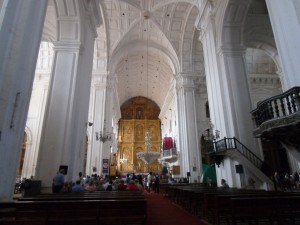 Famous for its cuisine and its beaches washed by the Arabian Sea along its west coast, Goa is also known for its churches, two of which in Old Goa are on the World Heritage List of Unesco. Se Cathedral, in Portuguese-Gothic style, was consecrated in 1640. The church, dedicated to St. Catherine took 80 years to build and is larger than any church in Portugal. Originally, the church had two towers but in 1776, one tower collapsed and [one altar 355]was never rebuilt.
Famous for its cuisine and its beaches washed by the Arabian Sea along its west coast, Goa is also known for its churches, two of which in Old Goa are on the World Heritage List of Unesco. Se Cathedral, in Portuguese-Gothic style, was consecrated in 1640. The church, dedicated to St. Catherine took 80 years to build and is larger than any church in Portugal. Originally, the church had two towers but in 1776, one tower collapsed and [one altar 355]was never rebuilt.
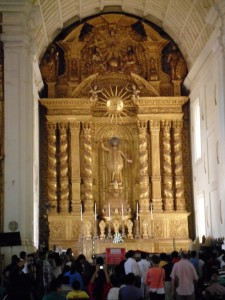 The massive-looking Bom Jesus Basilica, constructed of black laterite stone, holds the mortal remains of St. Francis Xavier, who spread Christianity in the Portuguese colonies and is regarded by many Catholics as the patron saint of Goa. The relics are taken down for veneration and for public viewing, from time to time. The last exposition was in 2004. The church was the first in India to be elevated to the status of a basilica. Consecrated in 1605, the church is considered the best example of Baroque architecture in India.
The massive-looking Bom Jesus Basilica, constructed of black laterite stone, holds the mortal remains of St. Francis Xavier, who spread Christianity in the Portuguese colonies and is regarded by many Catholics as the patron saint of Goa. The relics are taken down for veneration and for public viewing, from time to time. The last exposition was in 2004. The church was the first in India to be elevated to the status of a basilica. Consecrated in 1605, the church is considered the best example of Baroque architecture in India.
Goa is hot and humid most of the year. The monsoon rains arrive in early June and last until late September. Almost half of Goa is covered by equatorial forest located in the eastern interior and owned by the government. The region’s great biodiversity has been compared with the Amazon basin. Goa has many national parks and wildlife sanctuaries, including the Salim Ali Bird Sanctuary on the island of Chorao. The interior is also rich in minerals and ores; mining is Goa’s second largest industry.
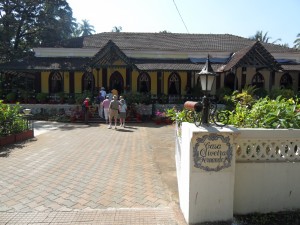 The architecture of Goa combines Indian, Islamic and Portuguese styles. Throughout Goa, there are homes built in the Indo-Portuguese style, although most of them are in a poor condition. Particularly noticeable are the red tile roofs. Portuguese influences are also visible in some of temples.
The architecture of Goa combines Indian, Islamic and Portuguese styles. Throughout Goa, there are homes built in the Indo-Portuguese style, although most of them are in a poor condition. Particularly noticeable are the red tile roofs. Portuguese influences are also visible in some of temples.
Goa important museums are the Goa State Museum and the Naval Aviation Museum. Less known to visitors is the Goa Science Centre and the National Institute of Oceanography (NIO).
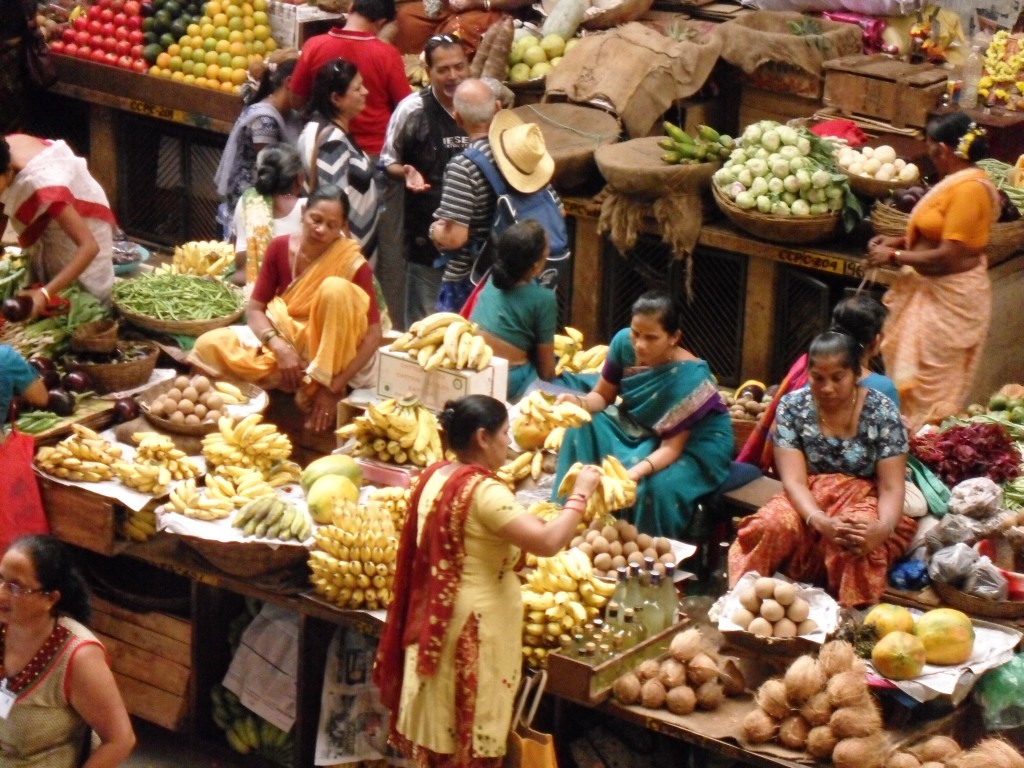 The cuisine of Goa is famous for its rich variety of fish dishes cooked with elaborate recipes. discover Goa’s unique blend of Indian and Portuguese cultures, Coconut and coconut oil are widely used along with chili peppers, spices and vinegar giving the food an unusual flavor. Interestingly, the cusine is divided into Goan Catholic and Goan Hindu cuisine, each with distinct tastes and characteristics as well as preparations. The rich variety of Goa cuisine starts in its colorful markets. www.goa.gov.in
The cuisine of Goa is famous for its rich variety of fish dishes cooked with elaborate recipes. discover Goa’s unique blend of Indian and Portuguese cultures, Coconut and coconut oil are widely used along with chili peppers, spices and vinegar giving the food an unusual flavor. Interestingly, the cusine is divided into Goan Catholic and Goan Hindu cuisine, each with distinct tastes and characteristics as well as preparations. The rich variety of Goa cuisine starts in its colorful markets. www.goa.gov.in
[more to come]
By Kay Showker, at sea on the Nautica of Oceania Cruises

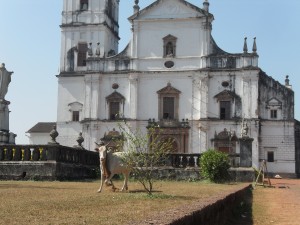
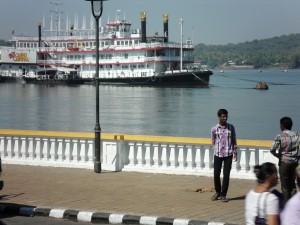
Leave a Reply